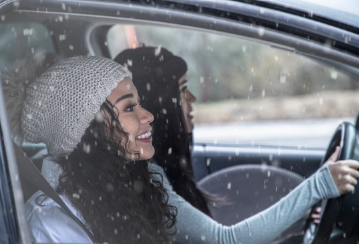Follow this checklist to prepare for a safe winter road trip

Thinking of taking a family road trip this winter? With restrictions on international travel, many Canadians are considering a Canadian winter road trip adventure as a much-needed break from home isolation. It may not be the same as an all-inclusive beach vacation, but at least it’s a change of scenery from your living room.
Winter road trips require careful planning and preparation in order to be done safely. Here are five key steps you should follow before leaving home to help keep you and your passengers safe on the road this winter.
1. Have your car inspected by a professional
As with any road trip or long-distance drive, it’s important to know your car is in good shape. Have a trusted professional inspect your car’s tire inflation level, as well as the brakes and fuel system before setting out. Ensure that you have cleared all snow and ice from your vehicle before putting it in drive — including windows, mirrors, lights, license plates and the roof.
2. Swap out your all-seasons for winter tires
Winter tires are a must for driving in cold temperatures and on icy roads. Unlike all-season tires, winter tires maintain their flexibility at sub-zero temperatures. This means they will maintain the traction your vehicle needs to operate safely in extreme cold, improving your handling in winter road conditions and shortening your braking distance. Since winter tires are typically safer when driving in cold temperatures, most car insurers will give you a discount if you have winter tires on your car from December to March.
3. Pack an emergency kit and keep it easily accessible
 It’s important to be prepared in the event of a collision or other roadside emergency, especially during cases of extreme weather and low temperatures. Public Safety Canada advises that the following emergency items be stored securely in your vehicle at all times:1
It’s important to be prepared in the event of a collision or other roadside emergency, especially during cases of extreme weather and low temperatures. Public Safety Canada advises that the following emergency items be stored securely in your vehicle at all times:1
-
Non-perishable food items, such as energy bars
-
Water in plastic bottles that won’t break if the water freezes
-
Blankets
-
Extra clothing and shoes/boots
-
First aid kit with seatbelt cutter
-
Candle in a deep can and matches
-
Wind-up flashlight
-
A whistle in case you need to attract attention
-
Roadmaps
-
Copy of your emergency plan
It is also recommended that you keep the following items in your trunk:
-
Sand or salt, cat litter will also work
-
Antifreeze and windshield washer fluid
-
Tow rope
-
Jumper cables
-
Fire extinguisher
-
Warning light or road flares
For more tips on packing your emergency kit, read our article “10 items you need in your car emergency kit.”
4. Check the weather forecast and driving conditions before setting out
While we can’t control the weather, it’s important to be aware of forecasted driving conditions before continuing with the next leg of your road trip journey. Tune in to your local weather channel broadcast or website right before you leave to check for updated weather warnings and road conditions. If extreme weather is in the forecast, try to modify your travel plans to avoid driving through it.
5. Review your insurance policy
Road trips don’t always go as expected, so it’s important to review your insurance policy ahead of time and know what you’re covered for. Some car insurance coverage add-ons can come in handy while on a trip. Car rental coverage is good to have in case something happens to your vehicle. If you have a breakdown, run out of gas or lock your keys in the car, roadside assistance will help as well. Then you can enjoy your winter road trip with the peace of mind that you, your passengers and your vehicle are protected.
If you have questions about your existing OTIP car insurance coverage contact us at 1-888-494-0090. If you’d like to get a quote for car insurance, chat with an OTIP insurance broker today at 1-888-892-4935.
If you enjoyed reading this article, subscribe to OTIP’s e-communications and you will get more news like this delivered straight to your inbox. Plus, you will be entered for a chance to win a $500 gift card!
1. Public Safety Canada